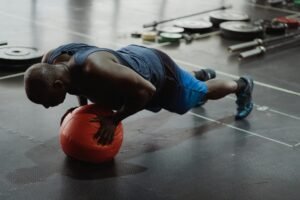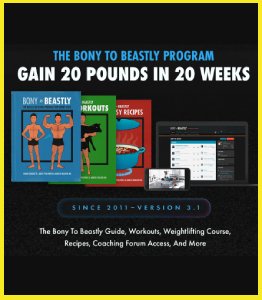Many people associate building muscle with gaining bulky mass, which can result in an intimidating appearance. However, building lean muscle is an excellent way to increase strength, improve overall health, and achieve a toned physique. In this comprehensive guide, we will explore the science behind muscle growth and provide tips on how to build muscle without the bulk. From the importance of proper nutrition and hydration to the best workout techniques and exercises, we will cover everything you need to know to achieve your fitness goals. Whether you’re a beginner looking to start your fitness journey or an experienced fitness enthusiast seeking new ways to build lean muscle, this guide is for you. So, let’s get started on building a stronger, healthier, and more toned body.
1. Introduction: The misconceptions about building muscle
When we think about building muscle, the first image that comes to our mind is a bulky bodybuilder, lifting massive weights and consuming tons of protein shakes. This preconceived notion has led many to believe that building muscle means gaining a lot of bulk and weight. However, this is far from the truth. Building muscles doesn’t necessarily mean becoming bulky or massive, but rather developing a toned and lean physique.
Another common misconception is that building muscle is only for men. This is not true as women can also benefit greatly from building muscles. In fact, it is a great way for women to increase their bone density and reduce the risk of osteoporosis.
Moreover, building muscle is not only about looking good, but it also has numerous health benefits such as improved metabolism, increased strength, and reduced risk of injuries. By building muscles, you can improve your overall fitness and lead a healthier lifestyle.
In this comprehensive guide, we will debunk the misconceptions about building muscles and provide you with effective tips on how to build muscles without gaining bulk. So, let’s get started!
2. What does building muscle without the bulk mean?
When most people think of building muscle, they picture a bulky physique that resembles a bodybuilder. However, building muscle without the bulk is a completely different approach to fitness. It involves increasing lean muscle mass, which gives your body a toned and defined appearance, without necessarily adding significant size or mass to your muscles.
This approach is perfect for those who want to achieve a lean, toned physique without the added bulk. It involves focusing on exercises that target specific muscle groups, while also incorporating a balanced diet and cardio routine to help burn fat and increase overall fitness. Building muscle without the bulk is all about achieving a strong, lean, and healthy body, rather than an overly muscular one. It’s important to note that this approach to fitness is not just for women, as many men also prefer a lean and toned physique over a bulky one.
3. How to achieve a lean and toned body

Image: pexels
Achieving a lean and toned body requires a combination of resistance training, cardio exercises, and a balanced diet. Resistance training is essential for building muscle and increasing your metabolism, which in turn helps you burn more calories throughout the day. This doesn’t mean you have to lift heavy weights like a bodybuilder. Instead, focus on using lighter weights with higher repetitions to tone and sculpt your muscles.
Cardio exercises are also important in achieving a lean and toned body. Not only do they help you burn calories, but they also improve your cardiovascular health and endurance. Incorporate activities such as running, cycling, swimming, or high-intensity interval training (HIIT) into your workout routine for the best results.
In addition to exercise, maintaining a balanced and healthy diet is crucial. Eat plenty of lean proteins, such as chicken, fish, and tofu, to aid in muscle growth and recovery. Incorporate complex carbohydrates, like brown rice and quinoa, to fuel your workouts and provide sustained energy throughout the day. Don’t forget about healthy fats, such as avocados and nuts, which are essential for hormone production and overall health.
Finally, make sure to give your body enough rest and recovery time. Muscles grow and repair during periods of rest, so it’s important to allow your body time to recover between workouts. Aim for at least 7-8 hours of sleep each night and consider incorporating yoga, stretching, or foam rolling into your routine to help with muscle soreness and recovery. By combining these elements, you can achieve a lean and toned body without adding bulk.
4. The importance of nutrition in building muscle without the bulk
When it comes to building muscle without the bulk, nutrition is key. It’s important to understand that you can’t out-train a bad diet, and this is especially true when it comes to building lean muscle mass.
Protein is the building block of muscle tissue, so it’s important to make sure you’re getting enough of it in your diet. Aim for at least 1 gram of protein per pound of body weight per day. Good sources of protein include chicken, fish, lean beef, eggs, and dairy products.
In addition to protein, carbohydrates are also important for building muscle. Carbs provide your body with energy, which you need in order to lift weights and perform other exercises. Focus on eating complex carbohydrates such as whole grains, fruits, and vegetables.
Finally, don’t forget about healthy fats. Fats are important for hormone production, which is essential for building muscle. Good sources of healthy fats include nuts, seeds, avocado, olive oil, and fatty fish.
Remember, building muscle without the bulk is not about restricting calories or cutting out food groups. It’s about fueling your body with the right nutrients to support muscle growth while maintaining a lean physique. By following a balanced diet that includes plenty of protein, carbs, and healthy fats, you’ll be well on your way to achieving your fitness goals.
5. Best workouts for building lean muscle
Building lean muscle requires a specific type of workout routine that focuses on high repetitions with lighter weights. This is because the goal is not to bulk up, but to tone and define muscle while also burning calories.
One great workout for building lean muscle is circuit training. This involves a series of exercises done back-to-back with little or no rest in between. The exercises should target different muscle groups and use lighter weights with higher repetitions.
Another effective workout for building lean muscle is Pilates. This low-impact exercise focuses on strengthening the core and developing long, lean muscles. It also helps improve flexibility and balance, making it a great addition to any workout routine.
Bodyweight exercises are also great for building lean muscle. These exercises use your body weight as resistance, making them easy to do at home or while traveling. Examples of bodyweight exercises include push-ups, squats, lunges, and planks.
Finally, high-intensity interval training (HIIT) is a great workout for building lean muscle. This involves short bursts of intense exercises followed by periods of rest. HIIT workouts can be done with weights, bodyweight exercises or even cardio exercises like running or biking.
Overall, the best workouts for building lean muscle focus on high repetitions with lighter weights, target multiple muscle groups, and include a mix of strength and cardio exercises. Incorporating these workouts into your routine will help you build lean muscle and achieve a toned, defined physique.
6. How to incorporate cardio for optimal results
When it comes to building muscle without the bulk, cardio is an essential component of your workout routine. Cardio exercises help to improve your cardiovascular health, burn calories, and improve your overall endurance. However, incorporating cardio exercises into your workout routine can be a bit tricky, especially if you’re trying to maximize muscle growth while keeping your body lean.
One effective way to incorporate cardio into your routine is to do it after your weight training sessions. This will allow you to burn off any excess calories and help your muscles recover faster. Additionally, you can also add a few cardio exercises in between your weight training sets to keep your heart rate up and your muscles working.
Another effective way to incorporate cardio into your workout routine is to do it on separate days from your weight training sessions. This way, you can dedicate your full attention to your cardio exercises without compromising your muscle growth. However, it’s important to keep in mind that doing too much cardio can negatively impact your muscle growth, so it’s important to find the right balance for your body.
Overall, incorporating cardio into your workout routine can help you achieve your goals of building muscle without the bulk. By finding the right balance between weight training and cardio exercises, you can optimize your results and achieve the lean, toned physique you desire.
7. The benefits of bodyweight training

Image: pexels
Bodyweight training is an excellent way to build muscle without the bulk. It involves using your own body as resistance to work your muscles, and it is often gentler on your joints than heavy weightlifting. Bodyweight exercises can be done anywhere and require little to no equipment, making them an accessible and convenient option for anyone looking to build muscle.
One of the key benefits of bodyweight training is that it helps to improve your body’s functional strength. This means that you will build strength that translates to real-life movements and activities, rather than just being able to lift heavy weights in the gym. Bodyweight exercises can also help to improve your balance, flexibility, and coordination, all of which are important for overall fitness and well-being.
Another benefit of bodyweight training is that it can be easily modified to suit your fitness level. Whether you are a beginner or an advanced exerciser, there are bodyweight exercises that can challenge you and help you to progress. As you get stronger, you can make the exercises more difficult by increasing the number of reps or sets, or by incorporating more challenging variations.
Overall, bodyweight training is a highly effective way to build muscle without the bulk, while also improving your functional strength, flexibility, and balance. By incorporating bodyweight exercises into your fitness routine, you can achieve your fitness goals while also enjoying the many benefits of this type of training.
8. How to increase intensity through supersets and circuit training
If you want to build muscle without the bulk, you need to increase the intensity of your workouts. One way to do this is through supersets and circuit training.
Supersets involve performing two exercises back to back with no rest in between. This not only increases the intensity of your workout but also helps to improve muscle endurance. For example, you could do a set of bench presses followed immediately by a set of pull-ups. This will work your chest and back muscles, providing a great upper body workout.
Circuit training involves performing a series of exercises in a row, with little to no rest in between. This is a great way to get a full-body workout while also increasing your heart rate and burning more calories. You can set up your circuit to include a mix of strength-training exercises and cardio exercises. For example, you could do a set of lunges, followed by jumping jacks, push-ups, and jumping rope.
Both supersets and circuit training are great ways to increase the intensity of your workouts and build muscle without adding bulk. Just be sure to give your body time to rest and recover between workouts to avoid injury and overtraining. Aim to incorporate these techniques into your workouts once or twice a week for best results.
9. The importance of rest and recovery
Many people think that building muscle is all about hitting the gym hard and lifting weights. While exercise is an important part of any muscle-building program, it’s important to remember that rest and recovery are just as crucial.
When we exercise, we are essentially breaking down our muscles. The actual process of building muscle occurs during the recovery period when our bodies repair the damage caused by exercise and build new muscle tissue. If we don’t allow our bodies enough time to recover, we can actually inhibit muscle growth and increase our risk of injury.
So how much rest do we need? This varies from person to person and depends on a variety of factors, including age, fitness level, and the intensity of your workouts. As a general rule, however, it’s important to give your muscles at least 48 hours of rest between workouts. This means that if you work your biceps on Monday, you shouldn’t work them again until at least Wednesday.
In addition to rest between workouts, it’s also important to get enough sleep. During sleep, our bodies produce growth hormone, which is essential for muscle growth and repair. Aim for at least 7-8 hours of sleep per night, and try to establish a regular sleep schedule to ensure that your body gets the rest it needs.
Finally, make sure to fuel your body properly with a balanced diet that includes plenty of protein, carbohydrates, and healthy fats. This will provide your body with the nutrients it needs to repair and build muscle tissue during the recovery period. By prioritizing rest and recovery, you’ll not only build muscle more effectively, but you’ll also reduce your risk of injury and improve your overall health and well-being.
10. Conclusion: Building muscle without the bulk is possible
In conclusion, building muscle without the bulk is completely possible. It’s all about understanding your goals and tailoring your workout and diet accordingly. By focusing on high-rep, low-weight exercises, and incorporating cardio into your routine, you can achieve lean muscle mass without adding unwanted bulk.
It’s important to remember that building muscle is a process that takes time and dedication. Consistency is key, so make sure to stick to your routine and track your progress along the way. Keep in mind that rest and recovery are just as important as the actual workout, so make sure to give your body the time it needs to heal and grow.
And lastly, don’t forget about the importance of nutrition. Fueling your body with the right nutrients and consuming enough protein is essential for muscle growth and repair. With the right mindset, workout routine, and diet, you can achieve your fitness goals and build the lean, toned physique you desire.







Leave a Reply